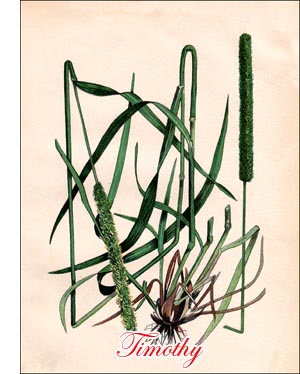Timothy seed
 For a seed crop Timothy should be harvested as soon as possible after the plant has reached full maturity - when the spike turns from green to yellowish. If harvested too early, the seed will be small, undeveloped and of poor germinating power. If harvested after it is ripe, the seed is apt to hull when it is threshed and to lose its bright silvery lustre, thus giving it the effect of old seed.
For a seed crop Timothy should be harvested as soon as possible after the plant has reached full maturity - when the spike turns from green to yellowish. If harvested too early, the seed will be small, undeveloped and of poor germinating power. If harvested after it is ripe, the seed is apt to hull when it is threshed and to lose its bright silvery lustre, thus giving it the effect of old seed.Timothy is commonly threshed with an ordinary grain thresher, although the best obtainable seed is harvested by hand and threshed by flail. It is grown in the St. Lawrence valley and Georgian Bay district, and the quality of this seed from the standpoint of boldness and bright silvery colour is not surpassed. It is sometimes saved from screenings of fall wheat sown after Timothy sod, but such seed is generally polluted with False Flax and other weed seeds not common in grass lands.
Seed of good quality is of a bright silvery lustre, and only a small amount is hulled. Dull-looking seed is either old or has been harvested or stored under unfavourable conditions. When newly threshed, the vitality of the hulled seeds is not inferior to that of the unhulled; but the naked seeds lose their vitality earlier than those enclosed in seed coats. If fully matured seed is preserved in a cool, dry place, it retains its vitality from three to five years; even when nine years old it gives a high total percentage of germinable seeds, although at that age the germ is usually perceptibly weakened.
The legal weight per bushel is forty-eight pounds.
The great bulk of the Timothy seed of commerce is clean when compared with the seeds of other grasses and clovers. The principal weed seeds to be guarded against when purchasing it are Oxeye Daisy, False Flax, Mayweed, Sheep Sorrel, Bladder Campion, Perennial Sow Thistle, Canada Thistle, Chickweed and Cinquefoil.
Timothy, like many other species of grasses, is attacked by Ergot (Claviceps). Ergot grains (sclerotia) vary in size and form according to the species of grain or grass on which they develop. The solid bodies are dark purple and may readily be detected protruding from the seedcoat in the spike. Meadows infested with Ergot should not be taken for seed.